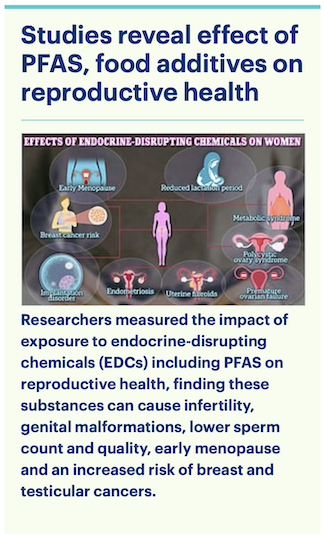 Certain ‘forever chemicals‘ may raise the risk of one of the fastest growing cancers in America, a study suggests.
Certain ‘forever chemicals‘ may raise the risk of one of the fastest growing cancers in America, a study suggests.
Doctors from Mount Sinai hospital in New York tested blood samples from people with and without thyroid cancer and found patients with the disease were 56 percent more likely to have levels of PFAS chemicals in their system.
PFAS are dubbed ‘forever chemicals‘ because they are virtually impossible for the body to break down and have been used to make thousands of everyday products since the 1940s – from nonstick cookware to raincoats.
Thyroid cancers have become increasingly common since then, spiking 240 percent between 1973 and 2002. But the leading explanation for this has been improved diagnostic abilities that allow doctors to catch diseases early.
The chemical studied here is called n-PFOS, which is most commonly used as a stain repellant in clothing and carpeting, as well as a grease-resistant coating for food packaging.

Researchers found that with every time PFAS levels in blood samples doubled, the risk of being diagnosed with thyroid cancer increased 56 percent
The Mount Sinai study adds valuable evidence to support suspected links between PFAS exposure and thyroid cancer.
Dr Lauren Petrick, a public health professor at the Icahn School of Medicine at Mount Sinai and co-author of the study, said: ‘To our knowledge, this is the first human study to look at associations between PFAS exposure and risk of thyroid cancer diagnosis.’
PFAS chemicals disrupt the function of the endocrine system, of which the thyroid gland is a part. The researchers noted that PFAS in water is a major source of exposure, but did not detail how each person’s blood levels got so high.
When PFAS enter the body either through food and water that people eat and drink or by inhaling contaminated air, they can distribute throughout the body in tissues and organs.

PFAS is a common contaminant in many household items from cookware to hamburger wrappers. It can remain in the environment as well as human tissue for years, even decades, before being cleared out
Some PFAS compounds can bind to thyroid hormone receptors in order to mimic or block the body’s natural hormones, knocking the system out of balance. PFAS can also disrupt the release of thyroid hormones which are crucial for regulating the body’s metabolism.
When the system for managing and producing hormones is disrupted, the result can be unfettered cell growth and replication, a hallmark of cancer growth.
PFAS also cause inflammation in the body, leading to DNA damage in thyroid cells. This can result in genetic mutations that drive the creation of cancer cells.
The latest finding expands on previous research into links between thyroid problems and PFAS, specifically into the effects on pregnant women and their unborn babies.
The latest research uses blood samples from 88 adults with thyroid cancer and 88 healthy people that had been collected from 2008 to 2021 as part of the medical school’s expansive collection of patient health information and blood and serum samples.
All of the study subjects, whose average age was 46, came from the New York metropolitian area, which researchers considered a major benefit because it gave them ‘a diverse ethnic population’.
Thyroid cancer affects the gland in the front part of the neck that makes hormones to regulate the body’s metabolism, heart rate, blood pressure, and temperature.
This is part of the body’s endocrine system, which PFAS chemicals have been shown to disrupt due to their ability to mimic thyroid hormones and prevent the production or transport of hormones.
An estimated 44,000 Americans will be diagnosed with thyroid cancer this year and roughly 2,100 will die. The survival rate for most types of thyroid cancer when detected early is high – around 98 percent.
Once the cancer has spread to other parts of the body, that survival rate dips to around 70 percent.
More than 80 percent of the people with thyroid cancer had papillary thyroid cancer, which is the most common variety with the best survival rate. Five percent had follicular thyroid cancer, which is still survivable but typically more aggressive.
And 10 percent had a type of thyroid cancer of unknown origin, though some may have had the most adganced and agressive variety, anaplastic thyroid cancer.
They tested the blood plasma samples for eight different types of PFAS chemicals. When levels of n-PFOS in blood plasma were doubled due to exposure, the risk of receiving a thyroid cancer diagnosis ballooned 56 percent.
Dr Petrick said: ‘The results of this study provide further confirmation for the PFAS health crisis and underline the need to reduce, and hopefully one day eliminate, PFAS exposure.’
While the researchers found the strongest association between cancer and a specific sub-type of PFOS chemicals known as n-PFOS, they also found links between cancer and other types of forever chemicals.
Their research was published in the journal eBioMedicine.
PFAS chemicals have been in use since the early 20th century in manufacturing make raincoats water-repellant, and cookware non-stick.
Studies reveal effect of PFAS, food additives on reproductive health
 They also line help make up firefighting foam, food packaging and coat carpeting to repel stains. They have even been used in children’s toys.
They also line help make up firefighting foam, food packaging and coat carpeting to repel stains. They have even been used in children’s toys.
There ever-presence in daily life means the chemicals leech into the environment, such as when you scrub a frying pan clean in the sink.
PFAS have been found in drinking water supplies all over the US as a result of tainted run-off from chemical producing plants and widespread use of pesticides.
Certain parts of the country, such as Brunswick County, North Carolina and nearby Fayetteville, have seen disturbing clusters of cancers in their communities that are believed to be linked to a nearby plant formerly run by PFAS manufacturer DuPont.
And there is evidence to show that bad actors including DuPont and 3M knew about the deleterious effects of exposure to the very chemicals they were producing as far back as the 1960’s.
Concerns were raised repeatedly for decades. In the 1970s, DuPont-funded Haskell Laboratorie found that PFAS was ‘highly toxic when inhaled and moderately toxic when ingested’.
Tests in dogs in the same decade showed that animals that ingested a single dose of PFAS died up to two days later.
In 1980, DuPont also learned that two of eight employees who had been pregnant while working in their factories gave birth to babies with deformities.
But the company did not reveal the findings, instead saying the following year that: ‘We know of no evidence of birth defects caused by [PFAS] at DuPont.’
They also went on to assure employees that PFAS was no more toxic than ‘table salt’.
But rather than remove the chemicals from their manufacturing processes, the companies sat on that information, allowing risky products to enter people’s homes.
The cover-up has been likened to the action of big tobacco companies to downplay the risks of smoking for decades in order to protect their profits.
DuPont asserts that it does not make or produce PFOS or another forever chemical called PFOA, and its use of PFAS more broadly ‘is limited’.
DuPont had, however, been producing chemical called C8 since at least the 1980’s. C8 is the same chemical compound as PFOA.
For its part, 3M has previously said last year that it would discontinue the use of forever chemicals.
But the damage has already been done. It takes PFOS specifically nearly five years to reduce by half in the bloodstream and PFOA about three and a half years.
They can take hundreds of years to degrade naturally.
PFOS and PFOA do not break down in the environment and can easily move through soil to contaminate drinking water.
The chemicals are so well entrenched in the environment that an estimated 97 percent of Americans have PFAS chemicals circulating in their blood.
Dr Petrick said: ‘Today, it’s nearly impossible to avoid PFAS in our daily activities. We hope these findings bring awareness of the severity of these forever chemicals.
‘Everyone should discuss their PFAS exposure with their treating physician to determine their risk and get screened if appropriate. In addition, we need continued industry changes to eliminate PFAS altogether.’
Written by Cassidy Morrison for The Daily Mail ~ October 24, 2023
